|
|


ADVERTISEMENT
Buy Your own advertising
spaces!
.
Download Adobe Acrobat Reader to open [PDF] files.
Recent Visitors
Motorola's Shanghai Hope
2010. 10 March
 by Dan Jones
by Dan Jones
(lightreading.com)
Motorola Inc. (NYSE: MOT) claims that its deployment of TD-LTE in Shanghai for China Mobile Communications Corp. means that it is still a force to be reckoned with in the world of mobile broadband technology.
Motorola was selected by China Mobile to deploy the technology in seven pavilions around the Expo 2010 fair in Shanghai. The event runs from May until the end of October, and organizers claim that 70 million people will attend over that time frame.
The Motorola network covers around 5.28 square kilometers -- the equivalent of over "320 football fields," according to Bruce Brda, senior vice president and general manager of the Networks segment within Motorola's Enterprise Mobility Solutions and Networks business. The vendor has deployed 23 eNodeB base stations for indoor coverage. Motorola is using silicon from Sequans Communications for the gear and intends to supply a Long Term Evolution (LTE) USB dongle running at 2.3GHz and 2.6GHz.
Stephane Daeuble, senior manager of LTE Global Marketing at Motorola, says that the vendor now has "a running system" in Shanghai. The vendor has demonstrated the maximum speed of 112 Mbit/s. "The performance is around the 43 to 50 Mbit/s range once you've got a few people on the network," says Daeuble.
Motorola wasn't selected for high-profile LTE contracts in its home country, but the vendor is hoping that its work in Shanghai will stand it in good stead for a wider China Mobile deployment and other contracts.
"It's a demonstration that Motorola is a serious contender for LTE business," Brda says.
Time Division Long-Term Evolution (TD-LTE) is different from the LTE flavor being used in Europe and the US. The technology uses one channel -- rather than two -- for uplink and downlink and employs scheduling to control what gets sent where and when. The technology is supposed to make more efficient use of spectrum than its two-channel cousin.
Motorola isn't the only vendor working with China Mobile in Shanghai. The carrier is also working with Huawei Technologies Co. Ltd. and cooperating with ST-Ericsson on development of the technology. Motorola likes to note, however, that it has been selected to provide "backup networks for other vendors' TD-LTE systems," should the need arise.
Motorola is also working with KDDI Corp. on its LTE deployment. (See KDDI Goes LTE.) Daeuble thinks Motorola's knowledge of TD-LTE could even help it win contracts in the US and Europe further down the line.
"There's never enough spectrum," he argues. "Quite a few [carriers] are looking at TD-LTE as an add-on network, for applications like video broadcasting."
Source: www.lightreading.com


